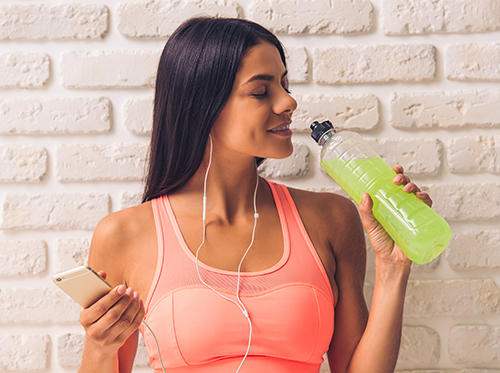Your Bright Smile
December 20th, 2023

Your bright smile means you’re happy, and it’s catching! Sharing your smile makes the people around you happy, too! And you can make sure your smile is as bright as it can be by keeping your teeth their cleanest.
Nobody wants food stuck in between their teeth, but cleaning your teeth doesn’t just mean brushing away any leftover bits of food. It also means brushing away the sticky plaque that builds up on your teeth every day. Germs in plaque called bacteria help make cavities, so it’s extra important to brush and floss away all the plaque you can.
When you were younger, a grown-up cleaned your teeth for you. Now that you’re ready to begin brushing and flossing on your own (with some adult help, of course), here are some good habits to start you off right.
Brush the Right Way
- Brush a tooth or two at a time with small brushstrokes and circles. Long back-and-forth brushstrokes miss a lot of plaque. Make sure you brush all the different sides of your teeth, not just the ones which show when you smile. Brush on the inside of your teeth and the tops of your molars (those big teeth in back). Use up-and-down strokes to clean behind your front teeth.
- Tip your toothbrush toward your gums while you brush along the gum line to get the plaque that likes to hide there.
- Don’t scrub your teeth. The tooth enamel that covers and protects our teeth is very strong, but brushing too hard can hurt it. Gentle brushing works!
- And don’t forget to gently brush your tongue for fresh breath.
Take Your Time
- You can’t keep your teeth their cleanest if you don’t spend enough time brushing them! That’s why dentists say it’s best to brush at least twice each day, for two minutes each time you brush.
- It’s hard to guess how long two minutes is, so use a little timer to keep track of the time. If you like music, play a song that lasts two minutes. Or ask a grown-up to time you—and maybe even brush with you!
Use the Right Toothbrush
- You want a brush that is just the right shape and size. A brush which is too big is hard to use—and hard to fit inside your mouth.
- You want a brush with soft bristles. Medium and hard bristles are too hard, and can scrape your enamel and gums. Stay with soft bristles, and your teeth and gums will be healthy and happy.
- Toothbrushes don’t last a very long time because their bristles start to break down after a while. After all, it’s hard work cleaning teeth twice a day every day! So it’s a good idea to change your toothbrush every three or four months, or whenever the bristles start to look a bit scruffy.
Use the Right Toothpaste
- Fluoride toothpaste helps protect your teeth from cavities and makes your enamel even stronger than it already is. There are plenty of fun-flavored fluoride (say that three times fast!) toothpastes to choose from.
- You don’t need too much. Once you’re brushing on your own, a small dab about the size of a pea will do the trick.
- Be sure to spit out the toothpaste after brushing. It’s for cleaning, not swallowing!
Don’t Forget to Floss
- Once you have any teeth that touch each other, you need to floss between them at least once a day. Flossing is the best way to get rid of the plaque that hides between your teeth where your brush just can’t reach.
- Flossing can be a little tricky at first, so you might need some help until you’re able to floss on your own. Dr. James McCreary can teach you the best way to floss, and a grown-up at home can help you until you’re ready to floss by yourself.
- There are lots of different kinds of floss. If you’re having trouble flossing, ask our Pensacola, FL dental team which kind is best for you.
Every smile is different, and yours is one of a kind. If you have any questions, talk to your pediatric dentist. Dentists don’t just take care of your teeth—they teach you to take care of your teeth, too! Your dentist can show you the very best way to keep your very own smile as bright and healthy as it can be.
Floss? Sticks? Picks? Which Should You Choose?
December 14th, 2023

You might have noticed that the dental aisle of your drugstore is larger than ever, with more options than ever for getting the spaces between your teeth their cleanest. Flosses made with different shapes, materials, and coatings. Wooden dental sticks. Flexible plastic picks. Tiny interproximal brushes. Water flossers. With all these choices, what’s a conscientious person to do?
- Find What Works Best for You!
We’ve come a long way from the one-size-fits-all floss of our grandparents. Today’s plaque-removing tools are designed to make interdental cleaning easier and more efficient for users with a variety of different needs.
- Floss Choices
Flossing properly is a very effective way to get rid of the plaque that builds up between your teeth and along your gum line—not to mention the food particles which your brush may have missed. And now there are options to suit both your needs and your preferences.
Modern flosses come waxed or unwaxed, flat or rounded, made of natural or synthetic material, flavored or unflavored. There are flosses designed for specifically for braces and eco-friendly, biodegradable flosses. If you’re not happy with your regular floss, a different size, material, or texture might make all the difference.
Even with all these choices, though, flosses don’t always suit everyone. Luckily, if you’ve had trouble with floss, you have many other options available for interdental cleaning:
- Floss Picks
These tiny, handled tools hold a piece of dental floss in their curved end. You can direct the floss to the perfect spot, which is especially useful if you’re having trouble reaching your back teeth or have mobility issues. Floss picks can be disposable or refillable, and come in different sizes to accommodate adults and children.
- Dental Picks
Back in the day, toothpicks were the go-to for dislodging food particles. But they weren’t designed for gum health and safety. Today, we have gentler, more efficient options for those of us who like the ease of using a pick and the convenience of being able to clean our teeth at work, at school, or on the go.
Triangular wooden picks are tapered to fit between the teeth and massage the gum line as they scour plaque from tooth enamel. Soft plastic picks are popular because their flexible tips fit easily in between the teeth, while their texture provides gentle scrubbing for your tooth enamel.
- Interproximal Brushes
Big name; tiny brush. These little cone-shaped brushes come in various sizes so they can fit snugly and comfortably between teeth whether widely or narrowly spaced. They’re especially handy for getting around wires if you wear braces.
- Water Flossers
These high-tech tools provide a pulsing stream of water to clean between the teeth. They’re particularly helpful for those with mobility issues and those with traditional or lingual braces. To make sure you’re getting the job done, choose a model with a dental seal of approval, which means it has been tested for safety and effectiveness.
With so many options, you can sample different flossing alternatives until you find the one that works best for you.
- Technique Is Key
No matter which product you choose, the key to effective plaque removal is your technique. You need to be thorough. You need to be gentle enough to protect your delicate gums, but not so gentle that you don’t remove any plaque.
Whichever method you choose, carefully follow directions to get optimal cleaning benefits while protecting tooth enamel and gum tissue. And remember, you have an expert ally in your corner—Dr. James McCreary and your team at McCreary Family Dentistry! If your hygienist is seeing a lot of plaque buildup at your next exam, ask for tips to improve your interdental cleaning technique and suggestions for the best products to accommodate your specific needs.
- Choose It—Then Use It!
Even after deciding on the best tool and technique, your teeth and gums won’t benefit from your research if your floss or pick or brush or water flosser is languishing in the medicine cabinet. While dentists recommend flossing at least once each day, if you have braces or a tendency toward cavities or gum disease, your dentist might recommend flossing more often.
Why is flossing so important? Even with the best brushing technique, it can be hard to reach plaque and food particles caught between the teeth and near the gum line. Removing plaque from between teeth can help prevent cavities, and it’s especially important for gum health.
Plaque and tartar are extremely irritating to gum tissue. This irritation causes inflammation, and you’ll soon start to see the first signs of gingivitis (early gum disease)—swelling, redness, bleeding, bad breath—when flossing is hit or miss. Over time, left untreated, gingivitis can lead to periodontitis, a serious form of gum disease that can cause tooth and bone loss.
When caught early, you can often reverse the irritation, inflammation, and unpleasant symptoms of gingivitis with a week or two of careful brushing and flossing. If your gums are bothering you despite your careful cleaning, it’s time to visit our Pensacola, FL dental office. There are lots of options available for getting your teeth their cleanest—but you have only one smile!
The Consequences of Sports and Energy Drinks
December 7th, 2023

They’re refreshing and tasty. They’re easy to find and pretty cheap. They help us get through a long day or a long workout. They’re everywhere.
We know it’s hard to say no to an energy or sports drink. That’s why Dr. James McCreary and our team want to make sure you know the effects that energy and sports drinks can have on your smile and overall oral health. You might just think twice next time you crave one.
There’s a common misconception that sports and energy drinks are somehow healthier than soda beverages. None is particularly good for you, but because sports and energy drinks have higher acidity levels, they put you on a fast track to enamel erosion, which can lead to cavities over time. However, studies show that energy drinks may be the worst of the bunch.
In a study published in General Dentistry, the energy drinks that showed the highest acidity levels were 5-hour Energy, Monster, Rockstar, and Red Bull Sugar free. These drinks almost doubled in acidity when compared to sports drinks. The sports drinks that came in second as far as acidity levels go were Powerade, Gatorade, and Propel.
You may be thinking, “What's the big deal; lots of other drinks damage your teeth, too,” and you’re right. Even all-natural beverages like orange juice and other fruit juices, which are advertised as full of vitamins, contain acid that damages tooth enamel. The point here is that moderation is key.
We certainly encourage you to choose a glass of orange juice over an energy drink, but if you feel like you just can’t give up your sports and energy drink habit, then please consider the following tips:
- Limit yourself to a certain number of said beverages a week and stick to it.
- Rinse with water after consuming an energy or sports drink.
- Brush your teeth after an hour of downing the drink, so your mouth has time to return to its normal pH level.
If you have any questions, don’t hesitate to give us a call at our Pensacola, FL office. Shoot us a message on Facebook, or let us know on your next visit!
What is hyperdontia?
November 29th, 2023

When a child is born, he or she will have 20 primary teeth and 32 permanent teeth. But sometimes kids are born with additional teeth, and our team at McCreary Family Dentistry calls this oral condition "hyperdontia." Primary teeth are the first set of teeth that erupt in your child's mouth, typically by the time they are 36 months old, and are shed by the time your child reaches the age of 12. Permanent teeth then take the place of the primary teeth and are usually fully-erupted by the time your son or daughter reaches 21 years of age. Anyone who develops more than 20 primary teeth or more than 32 permanent teeth has hyperdontia, and the additional teeth are referred to as supernumerary teeth.
While the cause of hyperdontia is not entirely clear, it is believed that there may be a genetic factor. Oral professionals have found that patients with extra teeth often have syndromes like cleidocranial dysplasia, Ehler-Danlos syndrome, Gardner syndrome, or cleft lip and palate. The prevalence of hyperdontia affects between one and four percent of the population in the United States, and the majority of cases are limited to a single tooth.
So, what is the best way to deal with hyperdontia? It really depends on the case. The treatment plan your doctor suggests varies according to the potential problem posed by the supernumerary teeth, as well as their type. Orthodontic treatment may certainly may help, but extraction can also be a good option. We recommend that children receive an oral evaluation or checkup no later than the age of seven. In addition to hygiene evaluation, this helps ensure your child does not experience hyperdontia problems.
If you suspect you or your child may be suffering from hyperdontia, please give us a call to schedule an appointment at our convenient Pensacola, FL office to be evaluated.







